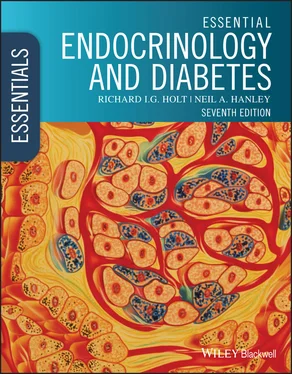Based on the success of previous editions, the book is still structured in much the same way. The first part is designed to create a knowledgeable reader, well prepared for the clinical sections or for more specific scientific study. To assist the many students coming from non‐scientific backgrounds we limit assumptions on prior knowledge. Chapter 1still covers the core principle of feedback regulation which underlies nearly all endocrine physiology and is vital for the correct interpretation of many clinical tests. Chapter 3has advanced to encompass the latest research made possible from next‐generation sequencing technology. The latter has already started to impact significantly on clinical investigation and diagnostics in endocrinology and diabetes. This is covered in Chapter 4, which also includes positron emission tomography (PET) imaging. It is important that aspiring clinicians, as well as scientists, appreciate these new approaches, their application and their challenges. The second part of the book still follows its organ or system‐based approach. We have retained the more specific scientific knowledge at the start of these chapters to underpin understanding, diagnosing and managing the relevant clinical disorders. The third part on diabetes and obesity has seen the greatest change from the previous edition. Over the last 8 years, there have been significant advances in the treatment of both type 2 diabetes, such as an expansion of the indications for incretin‐based therapies and the introduction of the SGLT2 inhibitors, and type 1 diabetes with the development of better insulins and the use of technology to support self‐management. Clinical algorithms have also changed and these have been updated.
As previously, the book is founded on our collective clinical and research experience and has been a truly collaborative venture. The book is designed to read as a whole, however, inevitably one of us has taken a lead with each chapter according to our own particular expertise. When we wrote the 5 thedition, NAH took the responsibility for Part 1 and Part 2, while RIGH was responsible for Part 3. Now on our third edition, we have each taken the opportunity to bring our experience to each of the chapters. Finally, we must thank a number of people. We are grateful for the skilled help of the team at Wiley. It is still important to recognise the excellent contribution of Charles Brook and Nicholas Marshall who authored the book up to and including the 4th edition. We are also very grateful to our scientific and clinical colleagues who have been the recipients of frequent questions and from whom we have sought valued opinions. The final thank you is to our families whose support and tolerance made this book possible. Particular thanks go to Tristan Holt, now a medical student, for his helpful comments in making the book as relevant as possible for our target audience.

Richard Holt is Professor in Diabetes and Endocrinology at the University of Southampton and Honorary Consultant in Diabetes at University Hospital Southampton NHS Foundation Trust. He is partly supported by the Southampton National Institute for Health Research Biomedical Research Centre. His research interests are broadly focused around clinical diabetes with particular interests in diabetes in pregnancy, cystic fibrosis diabetes and diabetes in young adults, and the relation between diabetes and mental illness. He also has a long‐standing interest in growth hormone.

Neil Hanley is Professor of Medicine at the University of Manchester and Honorary Consultant in Endocrinology at the Manchester University NHS Foundation Trust. His research over three decades has focussed on human development. His wider roles now include all aspects of biomedical and clinical research including the application of data science, and interests in how to triangulate healthcare, academia and the commercial sector to drive improved outcomes including economic growth.
Both authors play a keen role in teaching and training at both undergraduate and postgraduate levels. RIGH is a Fellow of the Higher Education Academy. NAH established an Academy for early career researchers at the University of Manchester and has led aspects of reviewing and refreshing national training portfolios in health research.
The following major international textbooks make an excellent source of secondary reading:
Melmed S, Polonsky KS, Reed Larsen P, Kronenberg HM, eds. Williams Textbook of Endocrinology , 14th edn. Saunders, 2019.
Holt RIG, Cockram C, Flyvbjerg A, Goldstein BJ. Textbook of Diabetes , 5th edn. Wiley‐Blackwell, 2017.
In addition, the following textbooks cover topics, relevant to some chapters, in greater detail:
Delves PJ, Martin SJ, Burton DR, Roitt IM. Roitt’s Essential Immunology , 13th edn. Wiley‐Blackwell, 2017.
Johnson M. Essential Reproduction , 8th edn. Wiley‐Blackwell, 2018.
Nelson DL, Cox MM. Lehninger Principles of Biochemistry , 7th edn. W.H. Freeman, 2017.
R.I.G. Holt
University of Southampton, Southampton, UK
N.A. Hanley
University of Manchester, Manchester, UK
5‐HIAA5‐hydroxyindoleacetic acid5‐HT5‐hydroxytryptophanαMSHα‐melanocyte‐stimulating hormoneACTHadrenocorticotrophic hormoneADHvasopressin/antidiuretic hormoneAFPα‐fetoproteinAGEadvanced glycation end‐productAGRPAgouti‐related proteinAIangiotensin IAIIangiotensin IIALSacid‐labile subunitAMHanti‐Müllerian hormoneARandrogen receptorAPS‐1type 1 autoimmune polyglandular syndromeAPS‐2type 2 autoimmune polyglandular syndromeCAHcongenital adrenal hyperplasiaCCKcholecystokinincAMPcyclic adenosine monophosphateCBGcortisol binding globulincGMPguanosine monophosphateCREcAMP response elementCREBcAMP response element‐binding proteinCNScentral nervous systemCRHcorticotrophin‐releasing hormoneCSFcerebrospinal fluidCTcomputed tomographyCVDcardiovascular diseaseDAGdiacylglycerolDEXAdual‐energy X‐ray absorptiometryDHEAdehydroepiandrosteroneDHT5α‐dihydrotestosteroneDIdiabetes insipidusDSDdifference in sex developmentEGFepidermal growth factorEPOerythropoietinERoestrogen receptorFDGfluoro‐2‐deoxyglucoseFFAfree fatty acidFGFfibroblast growth factorFIAfluoroimmunoassayFISHfluorescence in situ hybridizationFSHfollicle‐stimulating hormonefT3 free tri‐iodothyroninefT4 free thyroxineGCgas chromatographyGDMgestational diabetesGFRglomerular filtration rateGHgrowth hormone (somatotrophin)GHRGH receptorGHRHgrowth hormone‐releasing hormoneGIglycaemic indexGIPglucose‐dependent insulinotropic peptide (gastric inhibitory peptide)GLP1/2glucagon‐like peptide 1 or 2GLUTglucose transporterGnRHgonadotrophin‐releasing hormoneGPCRguanine‐protein coupled receptorGRglucocorticoid receptorGrb2type 2 growth factor receptor‐bound proteinhCGhuman chorionic gonadotrophinhMGhuman menopausal gonadotrophinHMG‐CoAhydroxymethylglutaryl coenzyme AHNFhepatocyte nuclear factorHPLChigh‐performance liquid chromatographyHREhormone response elementHRThormone replacement therapyICSIintracytoplasmic sperm injectionIDDMinsulin‐dependent diabetes mellitusIFGimpaired fasting glycaemiaIFMAimmunofluorometric assayIGFinsulin‐like growth factorIGFBPIGF‐binding proteinIGTimpaired glucose toleranceIPinositol phosphateIPFinsulin promoter factorIRinsulin receptorIRMAintraretinal microvascular abnormalities ( Chapter 14)IRMAimmunoradiometric assay ( Chapter 4)IRSinsulin receptor substrateIVFin vitro fertilizationJAKJanus‐associated kinaseLDLlow‐density lipoproteinLHluteinizing hormoneMAOmonoamine oxidaseMAPKmitogen‐activated protein kinaseMENmultiple endocrine neoplasiamIBGmeta‐iodobenzylguanidineMIBIsestamibiMISMüllerian inhibiting substanceMODYmaturity‐onset diabetes of the youngMRmineralocorticoid receptorMRImagnetic resonance imagingMSmass spectrometryMSHmelanocyte‐stimulating hormoneNEFAnon‐esterified fatty acidNICTHnon‐islet cell tumour hypoglycaemiaNIDDMnon‐insulin‐dependent diabetes mellitusNPYneuropeptide YNVDnew vessels at the discNVEnew vessels elsewhereOGTToral glucose tolerance testPCOSpolycystic ovarian syndromePCRpolymerase chain reactionPCSK1prohormone convertase 1/3PDEphosphodiesterasePETpositron emission tomographyPGE2prostaglandin E2PIphosphatidylinositolPIT1pituitary‐specific transcription factor 1PKAprotein kinase APKCprotein kinase CPLCphospholipase CPNMTphenylethanolamine N‐methyl transferasePOMCpro‐opiomelanocortinPPARperoxisome proliferator‐activated receptorPPGLphaeochromocytoma/paragangliomaPRLprolactinPTHparathyroid hormonePTHrPparathyroid hormone‐related peptidePTUpropylthiouracilRANKreceptor activator of nuclear factor‐kappa BRERrough endoplasmic reticulumRIAradioimmunoassayrT3 reverse tri‐iodothyronineRXRretinoid X receptorSERMselective ER modulatorSDHsuccinate dehydrogenaseSHBGsex hormone‐binding globulinSIADHsyndrome of inappropriate antidiuretic hormoneSoSson of sevenless proteinSRD5A1/25α‐reductase type 1 or 2SREserum response elementSSsomatostatinStARsteroid acute regulatory proteinSTATsignal transduction and activation of transcription proteinT1DMtype 1 diabetesT2DMtype 2 diabetest 1/2 half‐lifeT3 tri‐iodothyronineT4 thyroxineTGFβtransforming growth factor βTKtyrosine kinaseTPOthyroid peroxidaseTRthyroid hormone receptorTREthyroid hormone response elementTRHthyrotrophin‐releasing hormoneTSHthyroid‐stimulating hormoneUFCurinary free cortisolVvasopressin/antidiuretic hormone (previously also known as arginine vasopressin)VEGFvascular endothelial growth factorVIPvasoactive intestinal peptideWESwhole‐exome sequencingWGSwhole‐genome sequencing
Читать дальше














